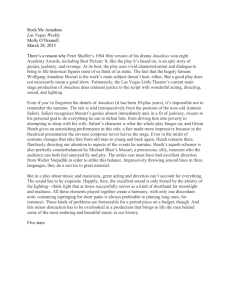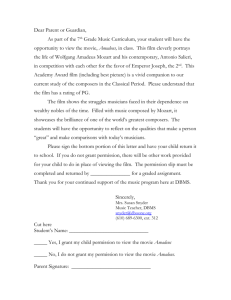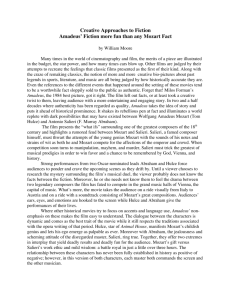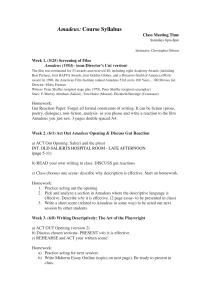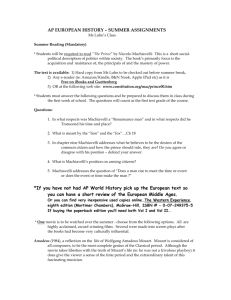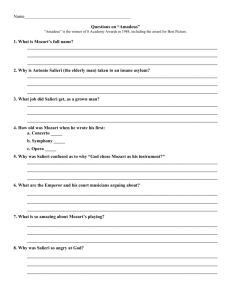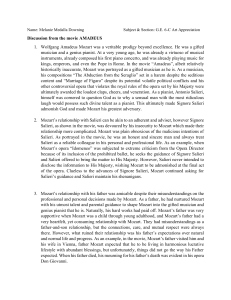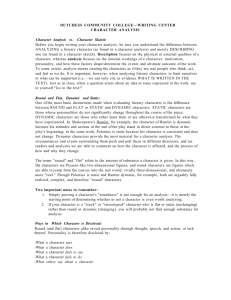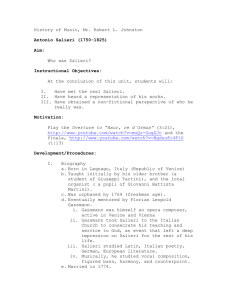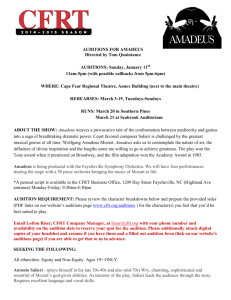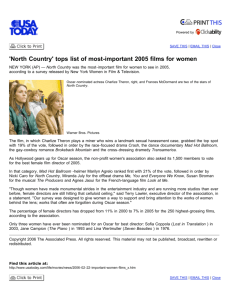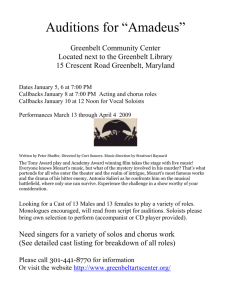Amadeuspresentationfinalversion
advertisement
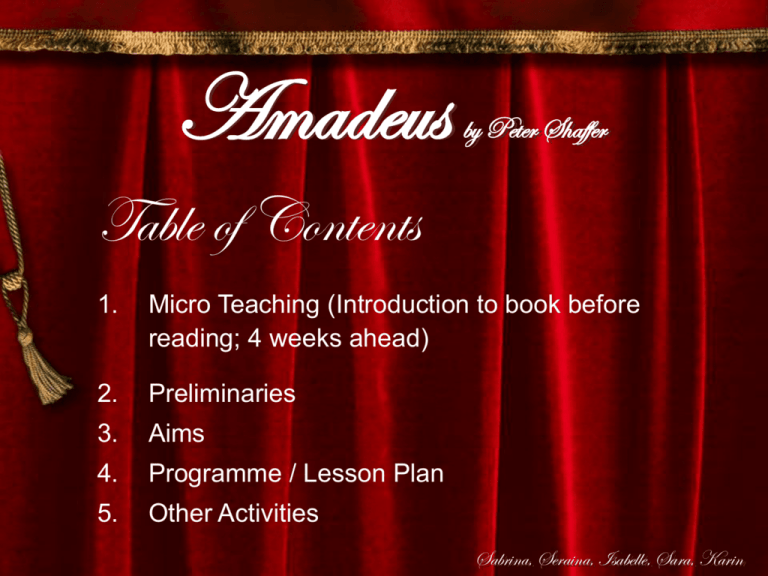
Amadeus by Peter Shaffer Table of Contents 1. Micro Teaching (Introduction to book before reading; 4 weeks ahead) 2. Preliminaries 3. Aims 4. Programme / Lesson Plan 5. Other Activities Sabrina, Seraina, Isabelle, Sara, Karin Preliminaries • Advanced students (fifth / third level = one year ahead of matura) • Original text without notes; 120 pages. • Time frame: Students receive book after introduction; they read individually, accompanied by specific reading tasks, and will have finished when literature sessions start (approx. 4 weeks). Teacher can be asked for assistance if needed. • Literature sessions: approx. 10 (double) lessons. Aims • Students cope with a literary work on their own / individual reading. • Students learn new vocabulary. • Students practice presentation skills. • Students learn to lead and have discussions based on prepared text passages: express their thoughts, opinions, etc. • Students learn about the main issues, conflicts and problems of the work (content) as well as about genre (drama), time (rococo / baroque, 18th century). • Students learn to work with secondary sources. Reading Tasks • Help students to understand and reflect their reading and prepare them for forthcoming discussions. • Include tasks and activities which will be conducted / needed in literature sessions. Focus on important text passages. • Production of short vocabulary work sheet. • Other Activities: Section Task Time for Reading Act One / I-VI Title for each act 1 week Act One / VII-XII Multiple choice 1 week Act Two / I-IX Complete the sentence 1 week Act Two / X-XX ‚Jumbled events‘ (LLC) 1 week Programme / Lesson Plan (1) L General Topic of Lesson Who / What activities Aim 1 Introduction to history / epoch: the 18th century (rococo, baroque) (teacher-led, presentation by students) • Brainstorming. • Ss: 15-20‘ presentation about the epoch. • Why was a book about the 18th century written in the seventies? • Contest: class divided into 3 groups, each has 10’ to prepare a radio report on the events => Ss decide which one was best. Ss learn about epoch & history; introduction into topic; Ss’ interest is aroused by the play, its background and influence. 2 Introduction to history / biography: Mozart & Salieri Music (teacher-led, presentation by students) • What do S know about main characters? • Ss: 5‘ presentation Mozart & 5‘ presentation Salieri. • Differences to literary work? Conflict? / Music. • Introduction of passage: Salieri: “God needed Mozart, do you see, to let Himself into the world. And Mozart needed me to give him worldly opportunities. And therein lay my enormous power.” Keep in mind for forthcoming discussions. Ss learn about historical persons and the diff. between characters and hist. persons; intro into conflict and main topic of play. Programme / Lesson Plan (2) 3 Characters: Amadeus & Salieri (student-led) • 15-20‘ presentation: characters, their development and conflict. • Other ss prepared passages to discuss (presenting group must also have passages ready). • Discuss how and (through) what power is exerted, related to passages discussed. What character traits are revealed? Where do they differ from the ‘originals’ (see presentations before)? • ½ of the class: write a letter to an agony aunt from Mozart’s perspective / ½ from Salieri’s. Closer investigation of characters: Ss learn about structure of a play: how characters develop in relation to plot/storyline. 4 Characters: Role of other characters, women (student-led) • 15-20‘ presentation: the role of the female characters. • Discussion. • Status of women (history). • Ss: “How would you try to help your husband Mozart if you were in Constanze’s position?” (Discuss and/or act it out). Ss learn about female characters in play as well as in the 18th century. Programme / Lesson Plan (3) 5 The importance of music; power and influence on society through music 6 Main issues, conflicts, characters... (teacher-led, presentation by students) • Ss: 5-10‘ presentation on role of music in Mozart‘s time. • Discussion. • T: society, behaviour; social structure and amendment (does Mozart fit in?). • Passage: „God needed Mozart ... Ss learn about music’s role and its importance in the play as well as in society in the 18th century; Ss learn about social structure. (student-led) • 5-10‘ presentation. • Activities, related to reading tasks ... • Debate: Ss get 5’ to prepare arguments; class divided in 2 groups: pro Salieri vs. pro Mozart. Ss work out the conflicts and character constellation of the play; can main issues be transported into modern times? Programme / Lesson Plan (4) 7 Drama: classical drama vs. modern structure Peter Shaffer 8 Amadeus: film adaptation (by Milos Forman) and the Oscar goes to... (student-led) • 5‘ presentation on Peter Shaffer. • 5‘ presentation on classical drama; 5‘ presentation on modern drama. • Why does the play offer this structure? • How would students produce the play? Ss know author and are able to distinguish classical and modern drama; Ss repeat last time’s question: comparison and relation from then and now. (teacher-led) • Introductory discussion: Is the play suitable for a film adaptation at all? • Ss watch the film AMADEUS. • Ss in “expert groups” of 5-6: discuss one of the following aspects of the film (categories for an Oscar): 1) costume design and make up 2) music and sound effects 3) adaptation of the screenplay 4) Actors • Ss collect and write down arguments why the film should win an Oscar in their category. Ss compare film adaptation to original play; Ss discuss and analyse different aspects of film Programme / Lesson Plan (5) 9 1 0 Amadeus: film • Ss form different groups of 4 (one of each expert group): adaptation Ss try to convince other Ss with their arguments to vote for (by Milos Forman) their Oscar category. • Ss write down their favourite Oscar category (not their and the Oscar own). goes to... • T collects votes and announces winner. • Final discussion: the film has actually won 8 oscars. Are they all justified? Why/why not? Final discussion, round up (plot, problems, evaluation...) • (teacher-led) • Go back to quote about the ‘enormous power‘ of Salieri => what do they think about it after all the other lessons? • Ss in groups of 3-5: write a ‘blurb’ for the back cover => choose the one that summarises the text best (+ discuss why it was best?). • T-led: collect Ss’ impressions of the book; Ss give their favourite (most remarkable /impressive etc.) passage of the book. Final discussion, evaluation. Other Activities • listen to and discuss ‘Rock up Amadeus’ by Falco (German song) • go and watch play / watch movie / listen to a concert by Mozart • perform play / passages in class • more on baroque / rococo art, i.e. music, architecture, paintings, clothes, history, etc.
